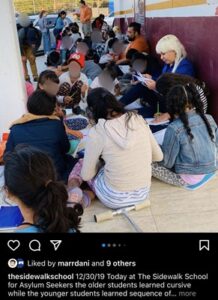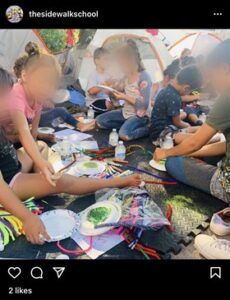Radical place-making in asylum tent settlements on Mexico-U.S. Border
By Ciara D. Ayala
Introduction
In 2018, the Trump administration instituted the Migrant Protection Protocols (MPP). Taking effect in January 2019, MPP mandated that individuals who arrived at the U.S.-Mexico border seeking asylum be given notices to appear in immigration court, then sent back to Mexico. The MPP program sent roughly 70,000 individuals to Mexico. President Biden terminated MPP at the start of his term, but in November 2021, the administration reinstituted this Trump-era policy.
As a consequence of MPP, informal settlements popped up in Mexican border cities. One such tent settlement emerged in Matamoros, Tamaulipas. The Sidewalk School is a local NGO working in the Matamoros encampment. What began as a group of volunteers from Brownsville, TX and Matamoros has grown into an official 501(c)3 that offers school classes and health services and donates supplies to asylum seekers. Although The Sidewalk School began in the Matamoros tent settlement, which at its height was home to 3,000 asylum seekers (Kriel, 2021), the NGO has moved as camps are torn down and pop up in other cities.
Analysis
MPP directly led to the creation of the tent settlements that popped up in Mexico. But what created the influx of migrants at the southern U.S. border in the first place? A recent report from the Congressional Research Service found that the main drivers of Latin American migration to the U.S. are “difficult socio-economic and security conditions” (Meyer, 2021). Plainly, Latin Americans are seeking asylum to escape extreme poverty, violence, and victimhood. Presumably, MPP was a part of the pro-white policies that President Trump sought to institute, as he favored individuals from European and Asian nations over those from “shithole” countries (Kendi, 2021).
Local volunteers, nonprofits, and faith-based organizations were the main actors providing material aid and legal assistance to the asylum seekers. As the future of U.S. border policy remains uncertain, NGOs will continue to play an important role in providing services and shelter, risking the creation of a “republic of NGOs.” When NGOs are the main providers of services, one risks coordination problems, contradictory assessment of community needs and the appropriate remedies, competency issues, and dependency on donations (Fawaz and Harb, 2020).
The informal tent settlements and the NGOs that service them offer an interesting case study in mobilities. As Mimi Sheller and John Urry state (2006), mobilities research “emphasizes that all places are tied into…networks of connections.” The Sidewalk School exemplifies this notion, showing that the social relationships between the asylum seekers and volunteers led to the specific services The Sidewalk School offers. For example, the presence of art teachers among those seeking asylum allowed The Sidewalk School to offer art classes. Furthermore, the day-to-day work of The Sidewalk School is extremely mobile. Similar to Frans Prasetyo’s description of the punk scene in Indonesia, The Sidewalk School has not been able to maintain a static, physical presence in the tent settlements (Prasetyo, 2017). The settlements move from site to site and city to city, and within a settlement, classes are held in different tents. This place-mobility is responsive to and perfectly suited for the environment.
The Sidewalk School’s curriculum is also an example of what John Friedmann calls “social learning” (Friedmann, 1987). Social learning occurs when people come together to discuss relevant issues that affect them and come to decisions about how to address these problems. Importantly, the flow of information should go between “expert technician” and “community beneficiary” (Sanyal, 2018), fostering a dialogue to inform and shape community interventions. In this instance, The Sidewalk School’s service offerings are based on the needs of the community because the community voiced their own needs. For example, asylum seekers need self-care practices to help cope with the stress of seeking asylum and living in a tent settlement, so The Sidewalk School offers yoga, art classes, and other self-care services.
Implications
The Mexican tent settlement may exist for quite some time, as the number of individuals arriving at the southern U.S. border is increasing. The Biden administration continues to enforce Title 42, which allows U.S. border enforcement officers to expel undocumented individuals from the United States and into Mexico. Moreover, President Biden has reinstated MPP. As a result, both the United States and Mexico should work closely with organizations to procure safe and habitable temporary housing for the asylum seekers in order to avoid the development of encampments symptomatic of a “republic of NGOs.” When NGOs are the main service providers, you risk coordination problems, inconsistent service delivery, differing, or even contradicting needs assessment and program implementation, and dependency on foreign donors. Additionally, NGOs are ultimately not beholden to their service populations, but rather to their donors and funders.
The asylum tent settlements are a unique challenge for planners, due to the inherently temporary and fraught nature of their development. After basic needs such as health and safety requirements are met, additional services should grow from the assets and needs of the community. Planners must embrace fluidity and flexibility in order to provide education services, art, recreational activities, and other resources, especially if asylum tent settlements become increasingly common as asylum at the southern border is halted.
The Sidewalk School is an example of a grassroots organization that implements social learning and practices place-making in a highly informal and mobile setting. Because of the geo-political reality of this particular case, formal international organizations were not able to mobilize to deliver services to the asylum seekers. In the future, if larger international aid agencies move into these settlements, they should look to organizations such as The Sidewalk School to provide guidance on how to engage with the community.

Sidewalk School students gather for class on the side of a building. See source here: The Sidewalk School Instagram

Children practice yoga in the Matamoros camp, receiving instruction virtually. See source here: The Sidewalk School Instagram

Sidewalk School art class in session in the Matamoros camp. See source here: The Sidewalk School Instagram

Men receiving haircuts in the streets in the Matamoros camp. See source here: The Sidewalk School Instagram